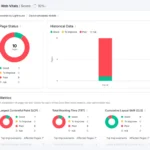
In 2026, the e-commerce landscape is more competitive than ever. Driving traffic to your online store is just the first step — converting visitors into customers is the real challenge. By improving your conversion rate, you can generate more sales without increasing traffic or ad spend.
Here’s a comprehensive guide on how to improve conversion rates for e-commerce in 2026.
Why Conversion Rate Optimization (CRO) Matters
Conversion Rate Optimization (CRO) focuses on turning visitors into buyers. A higher conversion rate means:
- Better ROI on marketing efforts.
- Increased revenue without more traffic.
- Improved customer experience and loyalty.
- Reduced cart abandonment rates.
In 2026, CRO combines data-driven insights, AI technology, and user-focused design to maximize sales.
1. Optimize Website Speed
Page speed is critical for both SEO and conversions. Slow-loading websites frustrate users and lead to abandoned carts.
Tips to improve site speed:
- Compress images and use modern formats like WebP.
- Minify CSS, JavaScript, and HTML.
- Use a Content Delivery Network (CDN).
- Remove unnecessary plugins and scripts.
2. Simplify Navigation and Site Structure
Visitors should be able to find products easily. Confusing menus or cluttered layouts reduce conversions.
Best practices:
- Use clear categories and filters.
- Include a search bar with predictive suggestions.
- Implement breadcrumb navigation.
- Keep checkout steps minimal and intuitive.
3. Improve Product Pages
Product pages are where conversions happen, so they must be compelling and informative.
How to optimize product pages:
- Use high-quality images and videos.
- Write detailed, benefits-focused product descriptions.
- Include customer reviews and ratings.
- Highlight scarcity or urgency (e.g., “Only 3 left in stock”).
4. Use Personalized Experiences
In 2026, personalization is a key driver of conversions. Tailored experiences make users feel valued.
Personalization strategies:
- Recommend products based on browsing history.
- Show dynamic pricing or discounts for returning customers.
- Use email and retargeting campaigns for personalized offers.
5. Optimize for Mobile Devices
With mobile commerce dominating, mobile optimization is non-negotiable.
Mobile CRO tips:
- Ensure responsive design for all devices.
- Simplify forms and buttons for touch screens.
- Use fast-loading pages and lightweight images.
- Streamline the checkout process for mobile users.
6. Leverage Social Proof
Social proof builds trust and encourages purchases.
Ways to use social proof:
- Display customer reviews and testimonials.
- Highlight user-generated content with products.
- Showcase best-selling or trending products.
- Include trust badges and secure payment icons.
7. Test and Optimize Continuously
Conversion optimization is an ongoing process. Regular testing helps identify what works.
Techniques for CRO:
- Run A/B tests on headlines, CTAs, and layouts.
- Analyze heatmaps to see where users click most.
- Use analytics to track behavior, drop-offs, and funnels.
- Adjust strategies based on data insights.
8. Offer Multiple Payment and Shipping Options
Limited options can lead to cart abandonment.
Best practices:
- Offer multiple payment gateways (credit cards, PayPal, UPI, wallets).
- Provide flexible shipping options (standard, express, pickup).
- Clearly display shipping costs and delivery times.
- Include hassle-free return policies.
Our Services SEO Services in Gorakhpur | SEO Company in Ameerpet | SEO Services in Nawada | SEO Services in Sasaram
Conclusion
Improving conversion rates for e-commerce in 2026 requires a holistic approach — combining speed optimization, user experience, personalization, mobile-friendliness, and continuous testing.
By focusing on data-driven strategies and customer-centric design, you can increase sales, reduce cart abandonment, and maximize the ROI of your e-commerce store.
Frequently Asked Questions (FAQs)
1. What is a good conversion rate for e-commerce in 2026?
A typical e-commerce conversion rate ranges between 2–5%, but it varies by industry. Focus on continuous improvement rather than comparing to averages.
2. Can AI tools improve conversion rates?
Yes. AI can personalize product recommendations, optimize pricing, and automate email campaigns to increase conversions.
3. How important is checkout optimization?
Extremely important. Simplifying checkout and reducing friction can dramatically improve conversions and reduce cart abandonment.
4. Do product videos increase sales?
Absolutely. Videos help customers understand products better, increase trust, and can boost conversions by 20–30% on average.
5. Should I use pop-ups for conversions?
Yes, if done right. Exit-intent or discount pop-ups can capture leads, but overusing pop-ups can annoy users. Keep them subtle and relevant.





